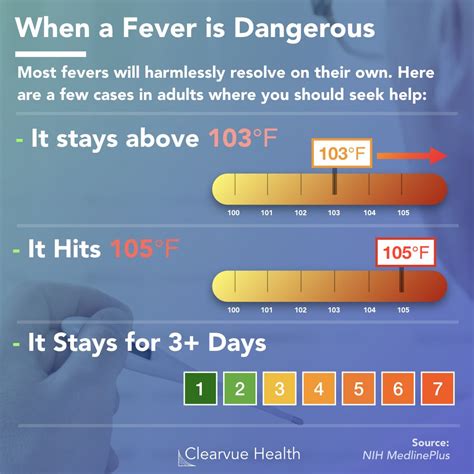Intro
Learn about the causes, symptoms, and treatment of a high fever of 104, including heat stroke, dehydration, and infection, to manage body temperature and prevent complications.
Having a fever can be a concerning and uncomfortable experience, especially when it reaches a high temperature of 104 degrees Fahrenheit. A fever is a natural response of the body's immune system to an infection or illness, and it can be caused by a variety of factors, including viral or bacterial infections, inflammation, or other medical conditions. In this article, we will delve into the world of fevers, exploring what causes them, how to manage them, and when to seek medical attention.
When the body detects an infection or illness, it releases chemicals that trigger a rise in body temperature, which can help to fight off the underlying cause of the fever. While a fever can be uncomfortable, it is often a sign that the body is working to recover from an illness. However, in some cases, a high fever can be a cause for concern, especially in certain populations, such as young children, older adults, or people with weakened immune systems.
It is essential to understand the importance of monitoring and managing a fever, especially when it reaches a high temperature like 104 degrees Fahrenheit. If left untreated, a fever can lead to complications, such as dehydration, seizures, or even organ damage. Furthermore, a fever can be a symptom of an underlying condition that requires medical attention, such as pneumonia, meningitis, or sepsis. Therefore, it is crucial to seek medical attention if you or someone you know is experiencing a fever, especially if it is accompanied by other symptoms, such as headache, stiff neck, or difficulty breathing.
Understanding Fever

There are several types of fevers, including acute, chronic, and recurrent fevers. Acute fevers are short-term and typically last for a few days, while chronic fevers can persist for weeks or even months. Recurrent fevers, on the other hand, are characterized by repeated episodes of fever that can be triggered by various factors, such as infections or allergies. Understanding the type of fever and its underlying cause is essential for effective management and treatment.
Causes of Fever
There are numerous causes of fever, ranging from common infections like the flu or common cold to more serious conditions like pneumonia or sepsis. Some of the most common causes of fever include: * Viral infections, such as influenza, respiratory syncytial virus (RSV), or human immunodeficiency virus (HIV) * Bacterial infections, such as pneumonia, meningitis, or sepsis * Inflammatory conditions, such as arthritis, lupus, or inflammatory bowel disease * Cancer, which can cause a fever as a result of the disease itself or as a side effect of treatment * Medications, such as antibiotics, antihistamines, or anesthetics, which can cause a fever as a side effectManaging a Fever

When to Seek Medical Attention
While a fever can be uncomfortable, it is not always a cause for concern. However, there are certain situations where it is essential to seek medical attention, such as: * If you have a fever that exceeds 104 degrees Fahrenheit * If you experience severe symptoms, such as headache, stiff neck, or difficulty breathing * If you have a weakened immune system, such as due to cancer, HIV/AIDS, or taking immunosuppressive medications * If you are pregnant or have a young child with a fever * If you have a fever that lasts for more than 3 days or is accompanied by other concerning symptoms, such as vomiting, diarrhea, or abdominal painTreatment Options

Prevention
Preventing a fever involves taking steps to reduce the risk of infection and illness, such as: * Practicing good hygiene, such as washing your hands regularly and avoiding close contact with people who are sick * Getting vaccinated against common infections, such as the flu or pneumonia * Avoiding sharing personal items, such as utensils, towels, or drinking glasses * Getting enough sleep and maintaining a healthy diet to support immune functionComplications

Long-term Effects
In some cases, a fever can have long-term effects, such as: * Fatigue, which can persist for weeks or even months after the underlying illness has resolved * Muscle weakness, which can occur if the fever has caused muscle damage or inflammation * Neurological problems, such as memory loss or difficulty concentrating, which can occur if the fever has caused brain damage or inflammationWhat is a normal body temperature?
+A normal body temperature is typically considered to be around 98.6 degrees Fahrenheit, although it can vary slightly from person to person.
How can I reduce a fever?
+You can reduce a fever by staying hydrated, resting, and using over-the-counter medications like acetaminophen or ibuprofen. Applying cool compresses or taking a cool bath can also help bring down the body temperature.
When should I seek medical attention for a fever?
+You should seek medical attention if you have a fever that exceeds 104 degrees Fahrenheit, if you experience severe symptoms like headache or difficulty breathing, or if you have a weakened immune system.
In conclusion, a fever of 104 degrees Fahrenheit can be a concerning and uncomfortable experience, but it is often a sign that the body is working to recover from an underlying illness. By understanding the causes of fever, managing it effectively, and seeking medical attention when necessary, you can reduce the risk of complications and promote a speedy recovery. We encourage you to share your thoughts and experiences with fevers in the comments section below and to share this article with others who may be interested in learning more about this topic.
